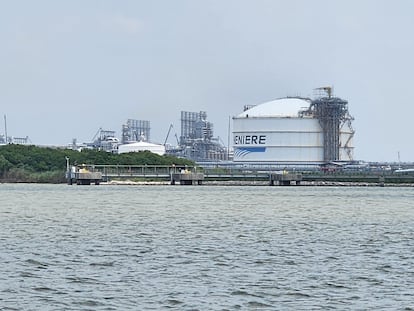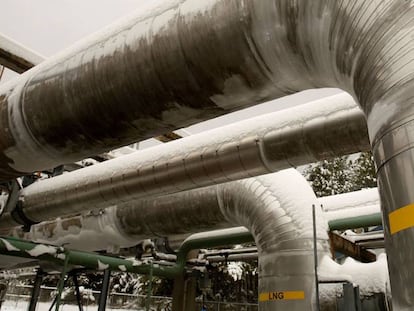The new gold rush in the US: Liquified natural gas
The North American country is already the main producer of this type of energy, which represented 40% of European gas consumption in 2022. It plans to multiply its production before the end of the decade


The heavy, humid air in the swampy plain between Texas and Louisiana invites laziness, an impossible sin in Port Arthur, one of the main enclaves in this ground zero of US energy. The town conveys a new frontier city atmosphere: bulldozers here, cranes there, entire brand new neighborhoods, schools to be built, infrastructure on its way. The job offer is insatiable: not all the positions on offer are covered. The influx of new workers has exhausted available housing, and prefabricated homes are the order of the day. A modern gold rush has shaken this energy center: the one unleashed by liquefied natural gas (LNG), the latest manna for the hydrocarbons sector.
“LNG is an extremely important pillar of our economy,” said District Judge Jeff Brannick. “With the expansion of its plants and others, our chemical industry now has 36 brands that supply products to virtually the entire US consumer sector.”
Until ten years ago, this industry was almost non-existent in the United States. Only when technological advances allowed it to tap its abundant shale gas reserves in Texas did it become a producer. It now has seven large liquefaction plants, which export 13 billion cubic feet a day. This year it will overtake Australia and Qatar to become the world’s largest supplier. And, with a whole series of new projects in the pipeline, it plans to establish itself at the forefront, with an ever-growing advantage over the rest.
The LNG business, a modality that freezes natural gas to liquefy it and allow its transport by ship, has exploded across the planet. Last year, with sky-high prices, 409 million tons were imported, compared to 386.5 million in 2021. The war in Ukraine was the main factor: deprived of the cheap Russian gas to which it had become accustomed, Europe began buying this product left and right to fill its reserves. It became the world’s main importer: 40% of the gas it consumed in 2022 was of this type, which travels by ship in a frozen state.
It is an expensive commodity, logistically complicated and harmful to the environment. But its defenders argue that its distribution is less subject to geopolitical fluctuations, at least for the West: US President Joe Biden guaranteed supplies to the EU and the UK, while countries like Bangladesh and Pakistan saw their contracts canceled in favor of Europe last year. Furthermore, its supporters argue, gas is a good wild card as the long road to energy change and carbon neutrality is undertaken.
“It’s the perfect solution because it’s clean and its availability can be scaled up or down quickly as needed, something weather-dependent renewables can’t do as easily,” boasts Corey Grindal, COO of Cheniere, the main American producer.
The demand for this product, experts predict, will continue to grow, encouraged by more moderate prices this year, a Europe that still needs this source of energy and an Asia whose economic activity is recovering.
US ambitions are evident in and around Port Arthur, one of the largest US LNG production hubs and a key location for US leadership aspirations in the sector. GoldenPass, a US-Qatari joint venture that will produce 18 million tons of gas a year starting next year, when it expects to come online, has already settled there.
Just a few miles away, Sabine Pass is a hive of activity. A ship, Pavillion Aranda, fills its tanks with liquefied gas. Another, the Esther Spirit, descends towards the sea with as much cargo as the depth of the channel allows. Upon its entry into the deep waters of the Gulf, it will supply itself with the rest. A third freighter climbs north, empty, to wait its turn. Every year, 1,830 ships with LNG pass through this canal, according to figures from the port authority. Each of these vessels can meet the heating needs of 43,000 US homes for a year, according to the Department of Energy.
Growing investments
Sabine Pass, which connects Sabine Lake with the Gulf of Mexico, is home to the largest LNG production plant in the United States and the second largest in the world. A behemoth of four gas pipelines and six liquefaction trains, each the size of a small airport terminal and producing a total of 30 million cubic tons of gas per year. It promises to grow: Cheniere, its owner, plans an expansion, now in its last phases of preparation, that will increase manufacturing to fifty million tons in 2029.
Cheniere’s is just one of the large expansion projects that the sector is planning in the US. Sempra Energy aspires to build another plant in Port Arthur. Venture Global has given the green light for the first phase of its facility in Plaquemines, Louisiana, and is moving forward with preparations for the second for a 20 million tonne per year project. Since last year, projects with a total value of $40,000 million have entered the final investment phase. By 2027, production could add an additional 125 million tons per year. It would be a 70% jump from today and roughly a quarter of EU consumption in 2022.
All that glitters is not gold, though. Some voices ask for caution: not all the projects proposed will end up becoming a reality. A fundamental part of the process involves obtaining the long-term gas sales contracts —15 to 20 years minimum— necessary to guarantee the viability of the new facilities and receive financing.
It’s an easier goal for large companies than for start-ups. Cheniere announced last week the signing of an agreement with the Norwegian Equinor for the supply of 1.75 million tons per year for 15 years, one more step towards the expansion of Sabine Pass. By contrast, Tellurian, founded by the father of US LNG, Charif Shoukri, has been forced to put land up for sale after losing several contracts.
Unknown future demand
It is also possible that the demand will grow below the gigantic supply that is on the way. In addition to the US, Australia, Qatar and other countries also foresee huge investments and brand new facilities. By 2027, an additional 80 million metric tons per year will be produced worldwide, according to the Institute for Energy Economics and Financial Analysis (IEEFA). “There are significant reasons to think that the global market simply cannot absorb so much supply so quickly,” the IEEFA notes.
The think tank has pointed out that Europe’s excessive appetite for LNG may fall in the coming years, given its roadmap for the energy transition, which forces it to reduce its gas consumption. In Asia, fluctuations in prices and changes in contracts have led emerging countries such as Pakistan and Bangladesh to announce new electricity generation projects using coal, a much more polluting fuel.
Others are more skeptical about these forecasts. “Perhaps European demand will fall in 10, 15 or 20 years, as other power generation projects come online. But in the short term, the demand for US LNG in Europe will be quite similar to what it has been in the last 18 months,” predicts Selby Bush Lilley, regional vice president of Sempra Infrastructure, operator, among others, of the Port Arthur LNG plant.
The city of Houston itself, a two-hour drive from Port Arthur, offers a counter-example. After six major floods in five years, the energy sector hub launched an action plan in 2020 to promote the use of renewable energy and reduce its carbon footprint by 40% by 2030. All municipal buildings are now powered by renewable energy.
“If it can be done in Houston, the energy capital of the world, it can be done anywhere,” the city’s mayor, Sylvester Turner, told a group of foreign journalists last week. “It has not been easy, but sometimes Mother Nature has ways of convincing even those who do not want to see things,” he stressed, alluding to those floods.
The future, in Asia
The industry, for its part, replies that the sector still has a long way to go, while renewables reach maturity. The future of LNG, they say, is not in Europe, but in an Asia where half of humanity resides and whose energy needs will continue to increase for the foreseeable future.
“Natural gas will probably continue to be in the energy system for decades,” says Kenneth III of Rice University in Houston. “While new technologies offer competitive options for the services that natural gas provides, time is needed to develop the supply chains and infrastructure needed to displace natural gas from its current uses. In addition, if the demand for natural gas is reduced, its prices will be lowered, which will discourage a rapid decrease in demand.”
In Port Arthur, meanwhile, the feverish activity continues. “We will continue producing. You can’t switch away from fossil fuels overnight. It will depend on the market and, obviously, federal policies will have an impact on how fast the energy transition is made. But to maintain the economic vitality of the United States and to continue supplying other countries, we are going to have to continue doing what we have been doing for a long time,” says Judge Brannick.
Sign up for our weekly newsletter to get more English-language news coverage from EL PAÍS USA Edition
Tu suscripción se está usando en otro dispositivo
¿Quieres añadir otro usuario a tu suscripción?
Si continúas leyendo en este dispositivo, no se podrá leer en el otro.
FlechaTu suscripción se está usando en otro dispositivo y solo puedes acceder a EL PAÍS desde un dispositivo a la vez.
Si quieres compartir tu cuenta, cambia tu suscripción a la modalidad Premium, así podrás añadir otro usuario. Cada uno accederá con su propia cuenta de email, lo que os permitirá personalizar vuestra experiencia en EL PAÍS.
¿Tienes una suscripción de empresa? Accede aquí para contratar más cuentas.
En el caso de no saber quién está usando tu cuenta, te recomendamos cambiar tu contraseña aquí.
Si decides continuar compartiendo tu cuenta, este mensaje se mostrará en tu dispositivo y en el de la otra persona que está usando tu cuenta de forma indefinida, afectando a tu experiencia de lectura. Puedes consultar aquí los términos y condiciones de la suscripción digital.
More information
Archived In
Últimas noticias
Maps of the US attack on Venezuela: Targets, airspace and deployed fleet
Venezuelans in exile: ‘This could be the end of a very dark chapter for Venezuela, but also the beginning of a time of uncertainty’
Key points of the military attack on Venezuela: Early morning bombings and a ‘captured’ president
World reactions to the US strikes on Venezuela
Most viewed
- Alain Aspect, Nobel laureate in physics: ‘Einstein was so smart that he would have had to recognize quantum entanglement’
- David King, chemist: ‘There are scientists studying how to cool the planet; nobody should stop these experiments from happening’
- Mexico completes its trade shift with the entry into force of tariffs on China and countries without trade agreements
- Reinhard Genzel, Nobel laureate in physics: ‘One-minute videos will never give you the truth’
- Oona Chaplin: ‘I told James Cameron that I was living in a treehouse and starting a permaculture project with a friend’










































